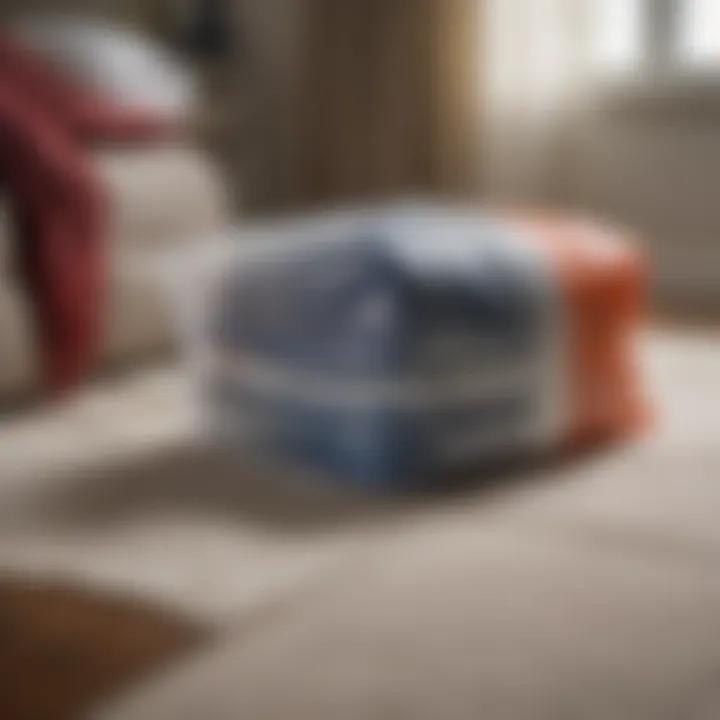Maximizing Ziploc Bags for Blanket Storage Solutions


Overview of Topic
When it comes to home organization, few items are as versatile as Ziploc storage bags. Primarily known for their food storage capabilities, these bags can also work wonders for managing household textiles, especially blankets. The need for optimal blanket storage arises from various factors, including seasonal changes, limited space, and the desire to keep fabrics fresh and clean. Ziploc bags not only assist in conserving space but also help in protecting blankets from dust and moisture, thereby maintaining their integrity over time.
The importance of using Ziploc storage bags for blanket organization cannot be overstated. It’s not just a matter of tidiness; it involves prolonging the lifespan of your cherished blankets, from thick comforters to lightweight throws. For many homeowners and particularly housewives, knowing how to maximize the utility of these bags can lead to more efficient home management, making day-to-day living a bit simpler while creating a more pleasant environment.
Common Challenges and Solutions
Common Issues Faced by Homeowners
Homeowners often grapple with various challenges when it comes to blanket storage. Some common issues include:
- Limited Space: Closets and storage areas can easily become overwhelmed with blankets, making it hard to find the ones you actually need.
- Dust and Insects: Keeping blankets free from dust and unwanted pests is another hurdle that many face, especially when storing items for longer periods.
- Moisture Damage: In rainy or humid climates, blankets may absorb moisture, leading to mildew and spoilage.
Solutions and Tips
To tackle these challenges effectively, consider these solutions:
- Utilize Clear Bags: Choosing transparent Ziploc bags allows for easy identification of contents without the hassle of opening each one.
- Optimize Air Removal: Take advantage of the ability to remove excess air from Ziploc bags. This not only saves space but also minimizes the risk of mildew.
- Label Bags: Labeling each bag with the blanket type or seasonality increases efficiency, making future retrieval simple.
"Using Ziploc bags is like giving your blankets a second home – compact, protected, and organized."
Product Recommendations
When selecting Ziploc bags for your blanket storage needs, the following products stand out in the market:
- Ziploc Big Bags: These large storage bags are perfect for bulky items like comforters and quilts. They are designed to be extra durable, so you don’t have to worry about rips and tears.
- Ziploc Vacuum Seal Bags: These bags come with a pump for removing air, providing superior protection against moisture and pests. Ideal for long-term storage, they help compress bulky items significantly.
- Ziploc Freezer Bags: Although primarily used for food, these bags can be handy for smaller blankets or throws. They are thicker and designed to resist punctures, thereby protecting your fabrics.
Benefits and Features
Each of the recommended products excels in specific areas:
- Durability: Made from strong plastic, these bags can withstand the test of time, ensuring that your blankets remain safe.
- Variety of Sizes: Available in various sizes, these bags can cater to everything from large comforters to smaller decorative throws.
- Sealability: The secure seals on Ziploc bags ensure that your blankets are protected from outside elements.
Step-by-Step Guides
Practical Steps to Implement Blanket Storage
To make the most of Ziploc storage bags for your blankets, follow these simple yet effective steps:
- Gather Your Blankets: Start by collecting all the blankets you wish to store. Assess them for wear and tear, and clean any that are dirty.
- Choose the Right Bags: Based on the size and type of blankets, select the appropriate Ziploc bags. Large bags for comforters and smaller ones for decorative throws are ideal choices.
- Remove Air Carefully: When placing blankets inside the bags, make sure to remove as much air as possible. This speeds up the packing process and keeps them compressed.
- Seal and Label: After sealing the bags tight, use a marker or label maker to identify the contents. This might save you some hassle next season.
- Store Wisely: Place the bags in a cool, dry location. Avoid storing them in areas exposed to humidity, as this could negate the benefits of using Ziploc bags.
In summary, utilizing Ziploc storage bags for your blankets offers a practical solution for maintaining organization and prolonging the lifespan of your textiles. By closely following these guidelines and recommendations, you can transform your storage strategies, ensuring your home remains clutter-free while protecting your cherished items.
Preface to the Storage of Blankets
Storing blankets may seem like a trivial task, yet it holds significant importance in maintaining their lifespan and functionality. Blankets often take up considerable space in our homes, which can lead to clutter if not managed properly. Effective blanket storage isn't just about tidiness; it's about preserving the quality and performance of these essential household items. The approach to storage plays a sizable role in keeping them fresh, clean, and ready for use at a moment's notice.
Importance of Proper Blanket Storage
Proper blanket storage is crucial for several reasons:
- Longevity: When you store blankets correctly, you help prevent wear and tear. Keeping them in an environment that controls humidity and light exposure preserves their threads and prevents fading.
- Hygiene: Blankets can quickly become a breeding ground for dust mites, allergens, and odors if not stored properly. Investing time in the right storage can elevate their freshness significantly.
- Space Efficiency: Especially in smaller homes, optimizing space is vital. Organizing blankets effectively can lead to more room for other essentials, reducing visual clutter and providing a serene living environment.
"Proper storage is like giving your blankets a second life, allowing them to serve you well for years to come."


To illustrate the point, consider the common household experience: a cozy winter evening that turns sour when reaching for a blanket only to find it stored haphazardly, dusty and wrinkled. That moment can easily be avoided with a bit of foresight in the storage process.
Common Challenges in Blanket Storage
While it may seem straightforward, several challenges often arise when it comes to blanket storage. Here's a quick rundown:
- Space Constraints: Not every home has the luxury of ample storage space, making it tough to find a good spot for larger blankets.
- Material Sensitivity: Different materials require different care. For example, a delicate wool blanket needs a different storage treatment than a cotton one, which can complicate the process.
- Environmental Factors: Temperature and humidity levels in storage areas can fluctuate, affecting the integrity of the blankets. A humid area might lead to mildew growth, while extreme dryness could cause fibers to weaken.
- Access Issues: Storing blankets out of sight can be problematic if they are not easy to retrieve. When the need arises, finding and pulling out a blanket should be the simplest affair, not a scavenger hunt among a chaotic pile.
Addressing these challenges heads-on prepares the groundwork for engaging with optimal storage solutions, such as Ziploc storage bags. Not only do they present an effective solution to many of these issues, but they also introduce a layer of convenience that enhances the overall storage experience.
Understanding Ziploc Storage Bags
When it comes to storing blankets, many homeowners find themselves grappling with the best methods to keep them clean, organized, and fresh. Enter Ziploc storage bags—a seemingly simple solution that packs a heavyweight punch when it comes to blanket management. Understanding the specifics of these bags is crucial for maximizing their potential in your home. This section unlocks the essentials behind Ziploc bags, shedding light on their material composition and size variability, two key elements that significantly impact their performance in blanket storage.
Material Composition of Ziploc Bags
Ziploc bags, at first glance, might seem like just plastic pouches. However, the real magic lies in the materials used to produce them. Typically made from low-density polyethylene (LDPE), these bags are not just durable but also flexible. LDPE is known for its ability to resist moisture and protect contents from dust and dirt.
Moreover, Ziploc's bags often feature a double zipper seal designed to create an airtight barrier, an essential characteristic when considering blanket storage. This not only keeps your blankets dry but also protects against any unwanted pests that might find their way into traditional storage options.
However, it’s wise to take note of the fact that not all Ziploc bags are created equal. Some are better suited for lighter fabrics, while others can handle heavier materials. Checking specifications is crucial to ensure you are choosing the right bag for your blankets, especially if you plan to store down or other heavier options.
Size Variability and Selection
Ziploc bags come in an array of sizes, which is another element that adds to their appeal for storing blankets. From standard gallon bags to larger storage bags, their variety makes it possible to find the right fit for almost any type of blanket.
When selecting a size, there are a few key factors to consider:
- Type of blanket: Larger comforters or thick quilts might require the spacious mega size, whereas thinner throws could fit snugly in standard or large bags.
- Storage space: Take into account where you plan to stash these bags. If your storage area is tight, going for a space-efficient size is smart.
- Usage frequency: If you might be accessing your blankets often, you might want to choose a size that will allow you to fit blankets neatly without having to struggle when pulling one out.
"Choosing the right size of Ziploc bag is just as important as the bag’s material—both work hand in hand to protect your blankets effectively."
Advantages of Using Ziploc Bags for Blankets
When it comes to keeping blankets in good shape and organized, Ziploc bags stand out as a practical solution. Their design and functionality provide notable benefits that go beyond merely tossing a blanket into any old container. We'll take a closer look at three key advantages: space-saving properties, protection against dust and moisture, and ease of accessibility and organization.
Space-Saving Properties
Ziploc bags have a claim to fame for their excellent space-saving qualities. When you look at cluttered closets or storage areas, you'll notice that space often disappears faster than you can say ‘overflow.’ Ziploc bags help tackle this issue. By compressing blankets down to a smaller size, they allow you to make the most of your available space.
- Organized Storage: Because they come in various sizes, it is possible to select the bag that best fits the size of your blanket. This means less wasted air and more easy access to what you need.
- Stackable Design: Once you have filled the bags, they can be stacked neatly in any storage area. This not only helps to create more visible space but also keeps everything tidy. Think of it like putting books on a shelf. When you organize them properly, you can always find what you’re looking for.
Protection Against Dust and Moisture
Another notable advantage is the protection Ziploc bags offer. Blankets can act like a magnet for dust, dirt, and moisture when stored improperly. Storing them in Ziploc bags can be a simple yet effective way to protect them.
- Dust Resistance: Ziploc bags, when sealed correctly, create a barrier against dust that can accumulate over time. This means there’s less need for frequent washing. The less you wash a blanket, the longer its fabric wears.
- Moisture Prevention: In humid climates, moisture can quietly invade your stored textiles. Ziploc bags are designed to keep moisture at bay. This is particularly crucial for anyone living in areas of high humidity or where unexpected spills can happen.
"Proper storage techniques protect your blankets and provide peace of mind, knowing they are ready when you need them."
Ease of Accessibility and Organization
Let’s not forget the benefit of accessibility. Ziploc bags make it easier to keep things in order and locate your blankets when you want to snuggle up for a movie or a chilly night.
- Quick and Easy Access: The transparent nature of Ziploc bags allows you to see what’s inside without opening every bag. This can save precious time—especially important when you’re in a hurry to find a specific blanket.
- Labeling Feature: Additionally, you can label your bags, ensuring that you don’t have to guess what’s inside. Labels like “Fluffy Throws” or “Winter Warmers” can turn a clutter of blankets into a well-organized collection.
In summary, using Ziploc storage bags for blankets provides significant advantages that cater to the practical needs of organization and comfort. They not only optimize physical space but also ensure that your blankets remain clean and easily accessible. In the grand scheme of household management, these bags can play a critical role in keeping your home well-organized.


Techniques for Storing Blankets in Ziploc Bags
Storing blankets might seem like a simple task, yet it can turn into a tricky endeavor without the right techniques in place. Utilizing Ziploc bags for this purpose doesn’t just save space—it shields your treasured blankets from the muck and grind of daily life. With proper techniques, you elevate the efficacy of this storage method, setting your blankets up for longevity and ease of access.
Preparation for Packing Blankets
Before diving into the packing process, preparation is key. Start by washing and thoroughly drying your blankets. This step removes any lingering odors or potential pests, ensuring they are fresh and clean when put away. Fold your blankets neatly to avoid unnecessary creasing, which might wear your fabric over time.
Another good tip is to consider the condition of your blankets. Certain materials might be more resilient than others. For instance, wool blankets need special care, while cotton ones may be a bit more forgiving. Knowing the fabric type can inform how you treat them before storage.
Additionally, gather your storage bags beforehand. Ensure they’re of the appropriate size to fit your blankets, as a snug fit prevents excess air that might invite moisture or mold. Having everything ready simplifies the process and makes it smoother.
Proper Folding Methods
Folding might appear mundane, but it plays a significant role in how well the blanket preserves. A common method is a tri-fold technique: lay the blanket flat, fold one side into the center, and then place the other side over it, reducing bulk. This method often results in a compact fold that fits perfectly into a Ziploc bag.
Alternatively, for thicker blankets, consider a rolling method. This way, you can compress the blanket tighter than folding would achieve. Roll from one end tightly, which gives a cylindrical shape. Once you’ve rolled it up, place it in the bag and seal it, squeezing out as much air as possible.
"Proper folding not only saves space but also keeps your fabrics in tip-top shape."
Sealing Techniques for Maximum Freshness
Once the blanket is folded or rolled, sealing it becomes the final protocol. Ziploc bags come with an easy-to-use closure system, designed to keep the air out. To effectively seal the bag, press it down toward the bottom and ensure air escapes before you finish sealing. The less air inside, the more protected your blanket will be.
For added assurance, consider storing Ziploc bags with a silica gel packet inside. This little trick helps absorb moisture, enhancing the longevity of your fabric. Some also choose to label their bags with the type of blanket or season of use, ensuring easy navigation during future retrieval.
With these methods in tow, you now have tools to maximize your use of Ziploc bags for blanket storage. A well-thought-out strategy not only optimizes space but also protects your beloved blankets from dust and unintended wear, all the while keeping them organized and easily accessible.
Considerations for Long-Term Storage
When it comes to storing blankets for the long haul, a few idiosyncratic factors come into play. Proper long-term storage is not merely about shoving those cozy covers into any bag you find lying around. Instead, it necessitates certain considerations that ensure your favorite snuggly items remain intact and usable when you finally retrieve them. Here, we will dive into two crucial aspects: the impact of temperature and humidity, and the importance of rotating stored blankets.
Impact of Temperature and Humidity on Storage
One cannot underestimate the significance of the environment where your blankets are kept. Just like a fish out of water, blankets can suffer in inhospitable conditions. Extreme temperatures can warp and degrade fabric over time. High heat can lead to fibers becoming brittle, while freezing temperatures often provoke moisture condensation, which isn’t a blanket's best friend.
Humidity levels are equally important. High humidity can foster mildew, while an overly dry climate might lead to static cling and fabric fragility. A good rule of thumb is to aim for a controlled environment. Keeping it around 60-70°F with humidity levels between 30-50% would be an ideal situation. A climate-controlled storage unit or a well-ventilated closet can be a game-changer in keeping those blankets in top-notch condition.
"The relationship between blankets and their storage environment is like that of a plant and its soil; neglect one, and the other wilts away."
Rotating Stored Blankets
Just because you’ve tucked those blankets away in Ziploc bags doesn’t mean they should sit eve rlastingly in the same position. Rotating stored blankets is a surprisingly crucial detail that’s often overlooked. Think of it like turning a roast in the oven — if you leave things unattended, some areas get too much heat while others remain cold.
By rotating your blankets, you allow for even distribution of wear and tear. It also ensures that fibers remain flexible and don’t become permanently flattened in one spot. Ideally, you should check on your stored blankets at least once or twice a year. When doing so, take the time to air them out. This simple act can revive the freshness and prevent any potential odors from settling in.
In summary, proper long-term storage for blankets involves keeping an eye on the temperature and humidity, as well as rotating them regularly. Adopting these considerations not only extends the life of your blankets but also guarantees that when you’re ready to use them again, they’ll be just as comfy and inviting as the day you packed them away.
Comparative Analysis with Other Storage Solutions
When it comes to the storage of blankets, the methodology used can have a considerable impact on organization, space consumption, and the preservation of fabric integrity. This section aims to dissect various storage options, primarily focusing on the advantages and drawbacks of using Ziploc bags in contrast to traditional fabric storage bins and vacuum-sealed bags. Understanding these differences can empower homemakers and property owners to make informed decisions regarding their storage choices.
Traditional Fabric Storage Bins
Fabric storage bins are an age-old solution for blanket storage. They offer a sense of charm and familiarity, making them appealing to many. However, they do come with drawbacks that can be problematic for some.


- Aesthetic Appeal: These bins often come in a variety of colors and designs, fitting seamlessly into home decor.
- Durability: Made from fabric or canvas, they can withstand weight and are often sturdy.
- Airflow: The breathable material allows for air circulation, reducing the risk of mildew.
But they aren't without their issues:
- Space: Traditional bins can take up considerable floor space, making them less ideal for smaller rooms.
- Dust: Over time, fabric bins may attract dust, defeating the purpose of storing clean blankets.
- Accessibility: If stacked, finding a specific blanket may feel like searching for a needle in a haystack.
"Choosing the right storage solution often means weighing functionality against aesthetics. Each choice has its pros and cons, and understanding them can guide you toward the best fit for your home."
Vacuum-Sealed Bags versus Ziploc Bags
Vacuum-sealed bags are often touted as a miraculous storage solution, especially for long-term needs. They compress items, saving space, but there's more to consider when comparing them with Ziploc bags.
- Compression: Vacuum bags shrink items down significantly, which is excellent for maximizing space. However, this can lead to wrinkles and require ironing before use.
- Protection: These bags provide robust protection from moisture and pests. On the flip side, if not handled carefully, the vacuum seal can be compromised, leading to potential damage.
- Accessibility: Unlike Ziploc bags, vacuum-sealed bags aren’t so friendly when you need to grab a blanket quickly. Getting your blanket might turn into a mini production number.
Meanwhile, Ziploc bags present many advantages:
- Ease of Use: Ziploc bags are straightforward. Simply place the blanket inside, seal it up, and you’re good to go.
- Reusability: They can be washed and reused, adding to the sustainability factor.
- Versatile Sizes: They come in multiple sizes, ensuring a customizable fit for different blanket types.
In summary, each storage option offers distinct considerations regarding space management, accessibility, and upkeep. Selecting between traditional bins and alternative methods, whether vacuum-sealed or Ziploc, largely depends on personal preferences, specific needs, and the amount of available space.
Environmental Considerations
When we talk about storing blankets in Ziploc bags, it’s essential to keep an eye on environmental factors. It might seem a bit off the beaten path, but the way we choose to store our items goes beyond mere practicality. Ziploc bags, while incredibly useful for keeping blankets organized and clean, also raise several environmental questions worth pondering.
Reusability of Ziploc Storage Bags
Ziploc bags are not typically known for their long-term durability, but they bring a lot to the table when it comes to reusability. The truth is, these bags can often be used multiple times before they need to be tossed away. Here’s how:
- After Emptying: Just rinse them out after using for snacks or small items. A good wash with warm, soapy water usually does the trick.
- Air Drying: Once cleaned, hang them upside down to ensure they dry out completely. Avoid direct sunlight as it can warp the plastic.
- Assess the Condition: Check for any tears or degradation before reusing. If they still hold up well, feel free to pack your blankets again.
This repeated use can cut down on the number of bags you need to purchase, culminating in less plastic waste. However, it's crucial to note that plastic, even when reused, adds to the landfill problem eventually. So, this method is commendable, but not a complete solution for environmental concerns.
Recycling Options and Best Practices
The recycling aspect of Ziploc bags is a tricky one. Not every recycling facility will accept plastic bags, including Ziplocs. However, knowing how to recycle these bags properly is essential for reducing environmental impact. Here are some practical steps:
- Check Local Programs: Before tossing them in the recycling bin, check if your local program accepts plastic bags. Many supermarkets provide drop-off bins specifically for plastic films.
- Invest in a Recycling Bag: Some stores offer specially designated bags for collecting plastic bags. Consider keeping one handy in your home, then filling it up and dropping it off.
- Follow Best Practices: Clean the bags and ensure they are dry before attempting to recycle. Contamination can lead to entire loads being rejected, which isn't good for anyone.
"Using Ziploc bags responsibly not only keeps your blankets safe but can also show a commitment to minimizing environmental footprints."
By adopting these strategies, homeowners and housewives can engage in better practices that not only enhance the utility of Ziploc bags but also contribute to a more sustainable lifestyle. Making these choices may not change the world overnight, but they can certainly make a difference in our own little corners of the planet.
The End and Recommendations
In wrapping up this exploration of Ziploc storage bags for blankets, it’s clear that these bags serve a purpose far beyond mere convenience. Their role becomes particularly significant when considering the varying factors that contribute to effective blanket storage. A thoughtful approach to this topic not only enhances the lifespan of blankets but also simplifies the lives of those managing household items. Understanding how best to utilize Ziploc bags can transform an often chaotic storage situation into a streamlined sanctuary.
Summarizing Key Benefits
The benefits of using Ziploc bags for blanket storage extend across several dimensions:
- Enhanced Protection: Ziploc bags provide a solid barrier against dust, moisture, and even pests, ensuring that blankets remain fresh and ready for use when needed. This is especially crucial for those living in humid or dusty environments where these elements can wreak havoc on fabric.
- Space Efficiency: One of the standout features is their ability to compress blankets, making it easier to fit them into tight spaces. This means more room in closets or under beds, which is invaluable for homeowners with limited storage.
- Organizational Clarity: With transparent bags, identifying contents becomes a breeze. No more rummaging through stacks of blankets; with Ziploc bags, one glance is often enough to know what’s inside.
- Seasonal Versatility: Storing blankets in a way that allows for seasonal rotation is easier, helping keep your living spaces tidy and functional. You can easily switch out warm throws in summer for lighter options in winter without the hassle.
It's straightforward to see why using Ziploc bags enhances blanket management—certainly worthy of consideration for every household.
Best Practices for Maintaining Storage Efficacy
When it comes to ensuring that your blankets are stored effectively within Ziploc bags, a few best practices stand out:
- Clean Before Packing: Always launder blankets before storing them. Stains or dirt can lead to mildew over time, so it's crucial that they are completely clean and dry.
- Use the Right Size: Selecting the appropriate size Ziploc bag for the blanket type is key. Too small will result in it bursting at the seams, whereas too large can lead to unnecessary wrinkles.
- Folding Technique: Fold the blankets neatly to maximize space. A good fold can significantly improve how many items fit within the bag.
- Air Removal: If possible, squeeze out excess air before sealing the bags. This not only aids in compressing the blankets for better fit but also reduces the potential for mildew forming due to trapped moisture.
- Label the Bags: Simple labeling with a permanent marker can save time later. Knowing exactly which blanket is where can save you the hassle of digging through unmarked bags.
Properly storing blankets using Ziploc bags is a simple yet effective step towards managing household organization and fabric preservation.
By adhering to these practices, you can ensure that your blankets are not only protected while in storage, but also ready to provide comfort whenever necessary. Taking the time to follow these guidelines will result in a more organized and efficient use of Ziploc storage bags, all while prolonging the life of your cherished blankets.







